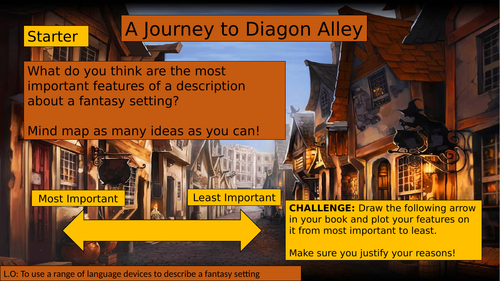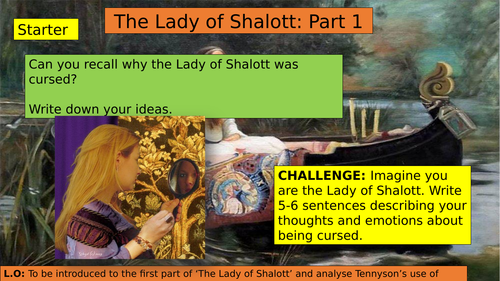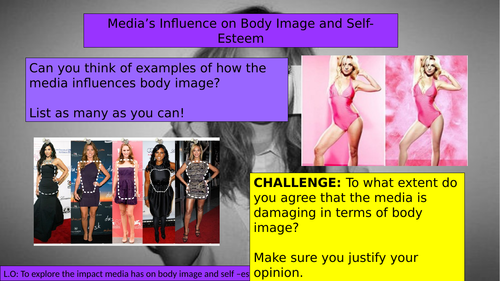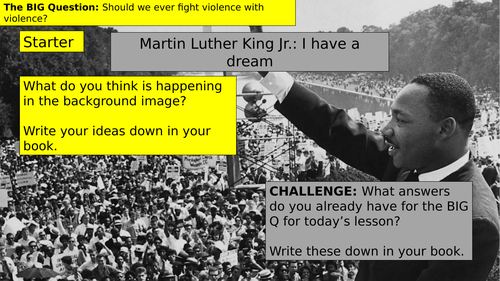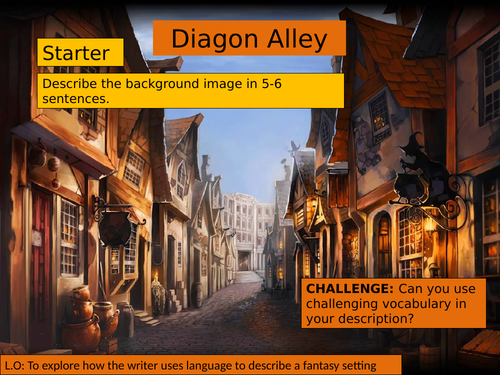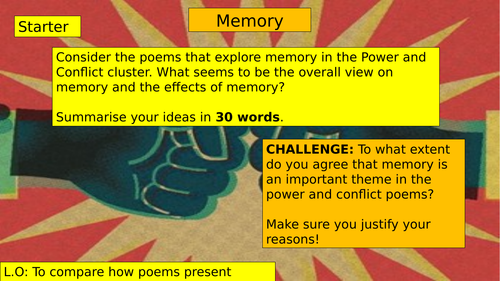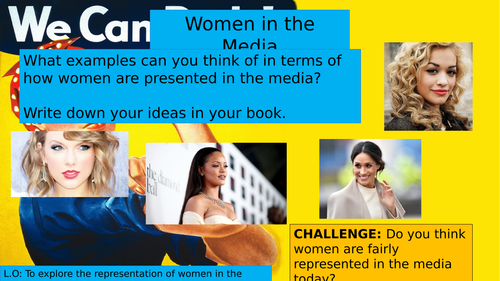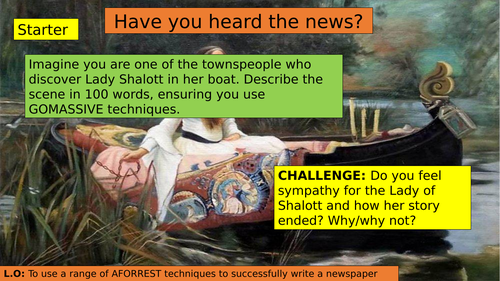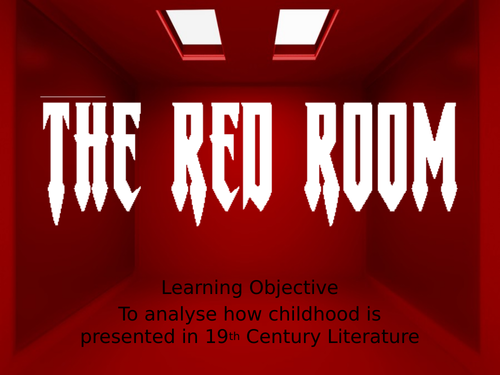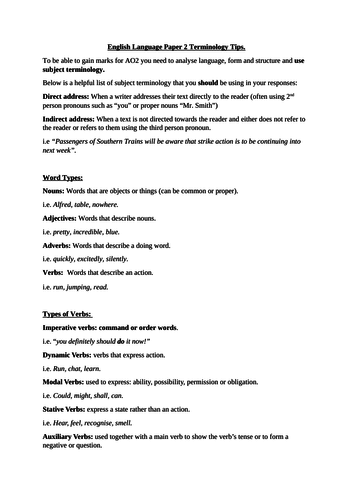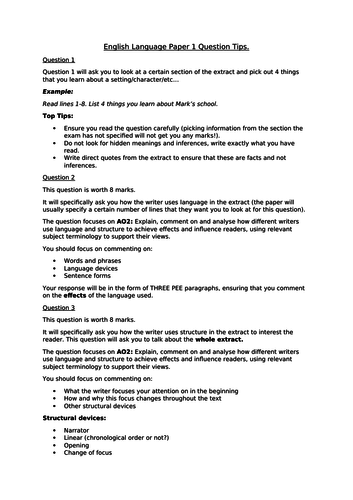60Uploads
17k+Views
4k+Downloads
All resources

AQA POWER AND CONFLICT POETRY: POWER OF NATURE
This is a GCSE lesson revision focusing on the power of nature that the AQA Power and Conflict poetry explores. The lesson features a range of activities that you can pick and chose from to suit your class. They range from pupils completing a comparison table to identify what poems link in terms of the power of nature; to a model text to analyse to support pupils in writing a response to a GCSE question. This is easily adaptable for a KS4 class of any ability.

KS3 (7/8/9) Introduction of the Lady of Shalott
This is a lesson planned for a high-ability Year 7 class. The lesson introduces them to the poem of ‘The Lady of Shalott’ and aims to ensure that pupils understand the plot of the poem and the legend it is based on. A copy of the poem is also attached and the lesson allows pupils to look at Camelot and the Legend of King Arthur. There is also a youtube link attached to a slide so pupils can read along with a spoken performance of the poem. Pupils then have an activity of making their own storyboard, selecting 8 key scenes. This lesson is easily adaptable for any KS3 class of any ability.

KS3 7/8/9 Harry Potter: Diagon Alley Description
This is a lesson planned for a middle-ability Year 8 class. It is a continuation lesson from a previous Harry Potter lesson where pupils looked at descriptions of Diagon Alley shops (see TES profile for this lesson). Pupils are now going to write a description imagining they have gone to Diagon Alley themselves and have visited a particular shop. There are images to help pupils gain initial ideas and a clip is included to help them begin to form descriptions. Group work is involved in the planning stages and roles of team leaders are available to pupils of a higher ability in the class. Worksheets are also included showing images of various shops. Each group can receive a set of images of one shop to focus their description on. This lesson is easily adaptable to any KS3 class of any ability.
Shops included:
Gringotts
Flourish and Blotts
Ollivander’s Wand Shop
Eeylop’s Owl Emporium
Madam Malkin’s Robes for all Occasions

Romeo and Juliet: Annotated (KS4)
I have created a booklet of 12 key scenes from Romeo and Juliet. These are:
The Prologue
Act 1, Scene 1: Sampson and Gregory
Act 1, Scene 1: Romeo and Benvolio
Act 1, Scene 2
Act 1, Scene 3
Act 1, Scene 5/ Act 2, Scene 2: Balcony Scene
Act 1, Scene 2: Romeo and Friar Lawrence
Act 3, Scene 1
Act 3, Scene 5
Act 4, Scene 3
Act 5, Scene 1
Act 5, Scene 3
The booklet contains extracts from each of these scenes and they are annotated by hand. Annotations include: terminology, analysis and contextual links.
This booklet could be used by the teacher, or as a resource for either revision, intervention or for students who may join later in a school year and have not studied the play.

KS3 (7/8/9) The Lady of Shalott Part One
This is a lesson planned for a high-ability Year 7 class. The lesson focuses on part one of the poem of ‘The Lady of Shalott’ and aims to ensure that pupils understand the language used by Tennyson to introduce the setting and Lady Shalott. There is an activity supporting pupils in picking out key language devices. There is then an activity supporting pupils in writing analytical paragraphs on the first section using the PEACE structure. This lesson is easily adaptable for any KS3 class of any ability.

(KS3 7/8/9) Media Influence on Body Image
This is a lesson planned for a middle-ability Year 9 class focusing on how the media influences body image. Pupils will discuss various images and the impact they have on teenagers and their body image. There is also a TED talk (link included in ppt notes) for pupils to watch on the influence of media. Pupils will then write a letter to Seventeen Magazine persuading them to stop body-shaming and focusing on skinny bodies. There are sentence starters included to support pupils in their writing. This lesson is easily adaptable for any KS3 class of any ability.

KS3 (7/8/9) Martin Luther King's 'I have a dream' speech
This is a lesson planned for a high-ability Year 7 class looking at injustice and analysing sections of the ‘I have a dream’ speech.There will be activities supporting them in picking out key quotes and language devices, before discussing these. Students will then focus on how to pick quotes apart and analyse these in detail, with examples to help. The final activity will require students to write an analytical paragraph exploring how the language used makes the speech persuasive. This lesson is easily adaptable for any KS3 class of any ability.

(KS3 7/8/9) Harry Potter: Diagon Alley
This is a lesson for a middle-ability Year 8 class focusing on fantasy worlds. This lesson looks at extracts describing key building in Diagon Alley. Pupils have a broken-down task of identifying key language devices in each extract. There is then a GCSE-style (English Language) question for pupils to write a paragraph responding to. There is a model paragraph to support pupils in writing their own. This lesson is easily adaptable for any KS3 class of any ability.

AQA POWER AND CONFLICT POETRY: MEMORY
This is a GCSE lesson revision focusing on memory and the AQA Power and Conflict poetry that explores this. The lesson features a range of activities that you can pick and chose from to suit your class. They range from a model text for pupils to annotate and identify the AOs in; to a planning sheet to support them in structuring a comparison essay. This is easily adaptable for a KS4 class of any ability. Planning sheet and model text copies are included.

Ready Player One: Creating your own Oasis
This is a lesson created for a middle-ability Year 8 class. It focuses on comparing two small extracts describing Wade’s situation and the Oasis. Pupils will select language devices used and the impressions they create for the reader. Pupils will then use these descriptions to write an opening description of their own Oasis. Sentence starters are provided to support pupils in their writing. This is easily adaptable for a KS3 class of any ability.

(KS3 7/8/9) Women in the Media
This is a lesson planned for a middle-high ability Year 9 class. It explores the representation of women in the media, looking at an advert from the 1950s up to magazine covers from the modern day. Pupils can annotate these to explore key features and the effects they create. There is also an activity where pupils can compare male and female magazine covers and consider how the genders are presented in the modern day. To finish, pupils can look at how the media describe male and female celebrities and write an analytical paragraph on this. A model text has been written to support them in their writing. All short extracts, magazine covers and adverts are included with the powerpoint. This lesson can easily be split into two/three lessons and adapted for any KS3 class of any ability.
Bundle

AQA GCSE POWER AND CONFLICT POETRY
This is a GCSE revision bundle focusing on key themes explore in the Power and Conflict poems. It includes a range of activities from: comparison tables, model texts to annotate and planning support to write GCSE-style responses. This is easily adaptable for any KS4 class of any ability.

(KS3 7/8/9) Social Media Influences on Teenagers
This is a lesson planned for a middle-ability Year 9 class on the influence of social media. It asks pupils to consider the purpose of social media and consider pros and cons during group work. There is a newspaper article on the impact of social media on teenagers for them to analyse (this can be independent or pair or group work) before pupils then need to respond to a question showing both sides of the argument, A model text is included to support pupils in their writing. This is easily adaptable for any KS3 class of any ability.

KS3 (7/8/9) Writing a speech against injustice
This is a lesson planned for a high-ability Year 7 class looking at injustice. Pupils will write a speech persuading an audience to fight against injustice. There will be activities supporting them in creating arguments and embedding language techniques. The final activity will require students to write their speech and there are sentence starters included to support those who may struggle to start. This lesson is easily adaptable for any KS3 class of any ability.

KS3 (7/8/9) The Lady of Shalott Newspaper Article
This is a lesson planned for a high-ability Year 7 class. The lesson focuses on reporting and consolidating the events in the poem of ‘The Lady of Shalott’ and aims to ensure that pupils understand the key events, as well as how to embed AFORREST techniques and how to structure a newspaper article. There is an activity supporting pupils in planning their language devices. This lesson is easily adaptable for any KS3 class of any ability.

(KS3 7/8/9) The Red Room in 'Jane Eyre'
This is a lesson planned for a middle-ability Year 8 class looking at the role of female children and the Red Room in ‘Jane Eyre’. Pupils will debate the role of children before looking at the extract where Jane is forced into the red room. There is support provided to help pupils annotate the extract through group work and sentence starters to write a response about it. This lesson is easily adaptable for any KS3 class of any ability.
Bundle

(KS3 7/8/9) Women in Society SCHEME OF WORK
This is a bundle of an entire scheme of work focusing on women in society and how they are presented. This was planned for a middle-ability Year 8 class but can easily be adapted for any KS3 class of any ability. The scheme of work starts with an opening assessment getting pupils to write an argument about the role of women, before exploring how women have been presented in classical literature and modern society.

KS4 English Language Paper 2 Terminology Tips
A worksheet for KS4 pupils explaining key terminology (with definitions) to use for English Language Paper 2.

KS4 English Language Paper 1 TOP TIPS
A worksheet provided top tips to pupils on how to approach English Language Paper 1.

Tracking Fate in Romeo and Juliet
This is an A3 worksheet for KS4 classes studying Romeo and Juliet. It allows them to write key examples from the play where fate is explored to make it easier to track its importance.



